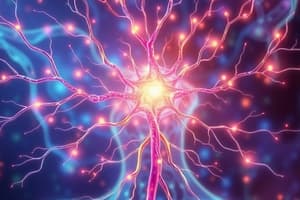Podcast
Questions and Answers
Match the following terms with their corresponding meanings:
Match the following terms with their corresponding meanings:
Soft porosity = Fracture porosity in Rock Physics modelling Hard porosity = Porosity associated with isometric voids Differential Effective Medium approach = Incorporating inclusions in small steps to estimate effective elastic properties Eshelby method = Estimating effective elastic parameters at small concentration increments
Match the following concepts with their descriptions:
Match the following concepts with their descriptions:
Slope of elastic moduli-concentration relationship = Determined by aspect ratio of inclusions Non-linear behavior of effective moduli = Result of interactions between inclusions and evolving microstructure Incremental approach in estimating effective properties = Adding small portions of inclusions step by step Effective properties dependency on construction path taken = Different properties obtained based on host material selection
Match the following statements with their correct implications:
Match the following statements with their correct implications:
Aspect ratio deviation from 1 in ellipsoidal inclusions = May result in more pronounced slope of elastic moduli-concentration relationship Increasing amount of inclusions = Leads to non-linear behavior of effective elastic moduli Preferred host material selection impact on effective moduli = Properties vary based on construction path taken Combining fractures with isometric pores in a model = Allows for dual porosity representation
Match the following models with their characteristics:
Match the following models with their characteristics:
Match the following with their corresponding description:
Match the following with their corresponding description:
Match the following rock physics models with their characteristics:
Match the following rock physics models with their characteristics:
Match the following concepts/models with their descriptions:
Match the following concepts/models with their descriptions:
Connect each model with its respective description:
Connect each model with its respective description:
Match the following terms with their definitions:
Match the following terms with their definitions:
Match the following model parameters with their descriptions:
Match the following model parameters with their descriptions:
Match the following shapes of inclusions with their descriptions:
Match the following shapes of inclusions with their descriptions:
Match the following features with their corresponding behaviors:
Match the following features with their corresponding behaviors:
Match the following statements with their corresponding models:
Match the following statements with their corresponding models:
Match the following terms with their descriptions:
Match the following terms with their descriptions:
Match the following with their characteristics:
Match the following with their characteristics:
Match the following concepts with their effects:
Match the following concepts with their effects:
Match the following terms with their outcomes:
Match the following terms with their outcomes:
Match the following models with their features:
Match the following models with their features:
Match the following terms with their definitions:
Match the following terms with their definitions:
Match the following factors with their impact on elastic properties:
Match the following factors with their impact on elastic properties:
Match the following models with their primary usage:
Match the following models with their primary usage:
Match the following steps with the corresponding actions in elastic properties estimation:
Match the following steps with the corresponding actions in elastic properties estimation:
Match the following with their descriptions:
Match the following with their descriptions:
Match the following models with their purpose:
Match the following models with their purpose:
Match the following concepts with their significance:
Match the following concepts with their significance:
Match the following terms with their definitions:
Match the following terms with their definitions:
Match the following methods with their applications:
Match the following methods with their applications:
Flashcards are hidden until you start studying




